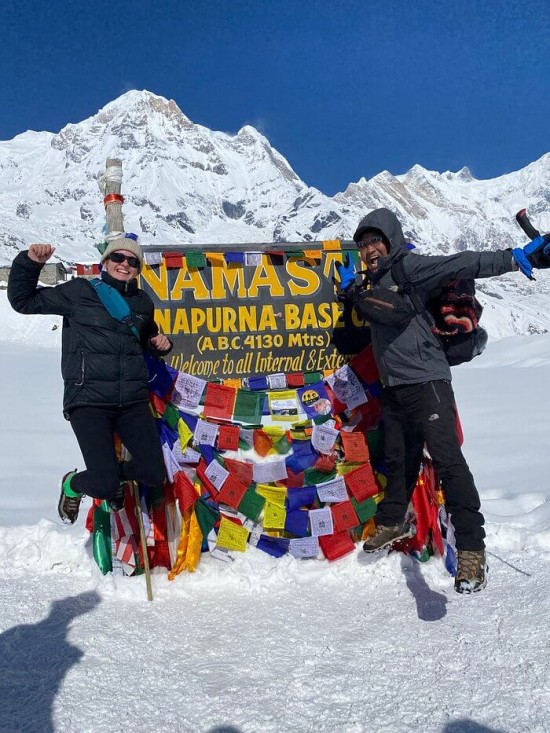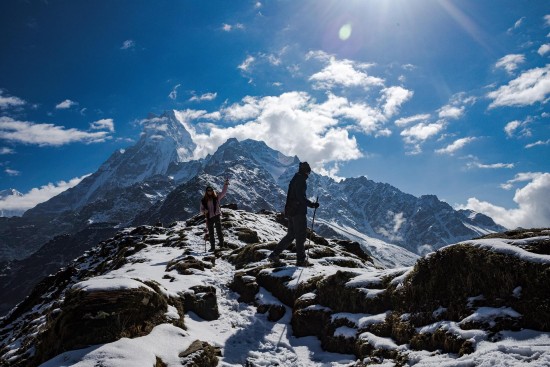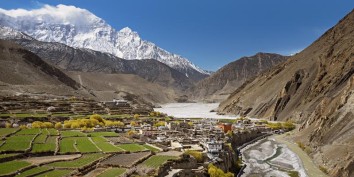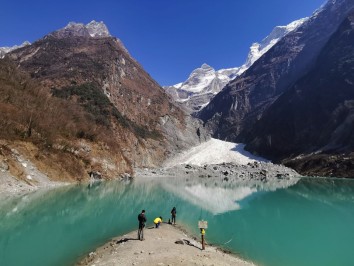Chulu East Peak Climbing

17% OFF


From USD 2499
Durations 18 Days
We Offer GROUP DISCOUNT In This Trip
100% Response Rate
Chulu East Peak Climbing Overview
The East Chulu Peak (6,584m) is one of the trekking peaks that captures the heart and mind with its exquisite beauty. It lies above Manang Valley in Nepal’s Annapurna region. Located at the southern extension of the Damodar Himal range, it also provides extensive views of Annapurna II, III, and IV, Gangapurna, Tilicho Peak, as well as the Dhauligiri range. Often considered a part of the Annapurna Circuit Trekking Route, this spectacular mountain allows trekkers to visit remote villages that are inspired by Tibetan culture alongside stunning alpine scenery. The summit offers a staggering view of some major Himalayan peaks from a 360-degree perspective.
Chulu East climbing is moderately difficult and perfectly suits climbers with basic mountaineering skills faced with an enticing challenge. Elements such as steep snow slopes and glaciers require the use of crampons and ropes as well as technical equipment. As classified by NMA (The Nepal Mountaineering Association), trekking peaks fall into Category B groups while allowing for easy access: special climbing permits issued alongside ACAP (Annapurna Conservation Area Permit) and TIMS cards are necessary to be granted access. In each season, various fees are charged, ranging from 100 to 400 USD based on demand. With not much technical challenge, ease provided personally motivates those wishing to conquer 6000m altitude summits; it manages to satisfy adventurous spirit while immersing them in breathtaking nature and rich Himalayan culture, making every mountaineer’s expedition remarkable beyond words.
What is Chulu East Climbing
Chulu East Peak stands at an elevation of 6584 meters. It is situated North of Manang, and offers a mixture of hiking and climbing in the form of a Himalayan cry bespoke for alpine enthusiasts. Like many other mountains in the Annapurna region, the Chulu East trek follows the famous Annapurna circuit trek, which runs through beautiful villages, breathtaking landscapes, coupled with exemplary interesting cultural sites/charming scenery before arriving in the foothills. While climbers of all skill levels are welcome, demarking towards the summit is particularly appealing for advanced summits as they can relish in mesmerising views spanning from Mt Annapurna II, III, to IV, Gangapurna, Dhaulagiri, and Tilicho peak.

Chulu East’s climbing difficulty is set at mid-level; thus, trekkers with some mountaineering experience will find this quite convenient. Moreover, it consists of basic tackling ice slopes and glaciers, such as crampon ropes alongside ice axes for simpler steps, allowing easier devices to be used, unlike other climbs that require professional gear. Just like similar trips within the country, visiting Nepal requires special permissions; thus, if traveling with climbing along ACAP and TIMS cards, a permit from NMA would be needed. Ensuring proper guidance along the entire process, especially thorough acclimatisation, will aid more favorable results, leading ensuring smoother climbs regardless of their first time pushing 6000+ triangular Everest gentle foreyer treks whilst sighting wondrous nature hindi idaidd those beautiful glimpses around aptly added culture of regions surrounding annapurneayeonsg orthu.
Key Points about Chulu East Peak Climbing
Stunning Location in the Annapurna Region
Chulu East Peak (6,584 meters) can be found within the stunning area of Annapurna in Nepal, northwest of Manang Valley. It is a challenging trek that offers exceptional views of mountain collages of Himalayan scale giants such as: Annapurna II, III, IV, Gangapurna, Dhaulagiri, and Tilicho Peak.
Moderate Technical Difficulty
Chulu East peak stands as a true epitome for trekkers who want to dive into the world of mountaineering. Though it considers moderate peak ranging from simple to moderate climbing skills coupled with a cram heap load of fitness level along with some sturdy ropes enhanced by alpine experience, it makes you conquer mountains along with and get a taste of icy breath.
Recognized Trekking Peak by NMA
NMA gave recognition to this peak by placing it under category “B” group trekking, thereby designating it as one accessible summits resting beneath the height of 6 thousand meters, rising, soaring summon making great training prep towards escalated exotic altitude gatherings.
Best Seasons for Climbing
With optimal Chulu East Peak set northern border climbers eye on core east sheath season break (15th March - mid November), autumn ranging outlook towards September-October stretches vigor bound period marked sky's best stability clarity alongside flawless conditions
Permits and Route Highlights
Climbers need a special climbing permit from the NMA, along with the Annapurna Conservation Area Permit (ACAP) and TIMS card. The route typically follows the Annapurna Circuit, blending cultural immersion with high-altitude adventure, making Chulu East one of the most rewarding trekking peak climbs in Nepal.
Chulu East Peak Climbing Highlight
- Reach the summit of Chulu East Peak (6,584m), one of the best trekking peaks in Nepal, offering panoramic Himalayan views of Annapurna II, III, IV, Gangapurna, Dhaulagiri, Tilicho, and Manaslu ranges.
- Trek through the classic Annapurna Circuit trail, exploring traditional Gurung and Tibetan-influenced villages like Pisang, Ngawal, and Manang with rich culture and scenic beauty.
- Experience moderate alpine climbing challenges, including snow slopes, glacial terrain, and high-altitude ascents—perfect for trekkers with basic mountaineering skills.
- Cross the iconic Thorong La Pass (5,416m) after the summit, combining your peak climbing experience with one of Nepal’s most legendary high-altitude treks.
- Climb in the best seasons—spring (March–May) and autumn (September–November)—when the weather is clear, dry, and stable for safe climbing and stunning views.
- A perfect introductory expedition for 6,000-meter peaks, ideal for adventure seekers preparing for more technical Himalayan climbs in the future.
- Requires official permits, including Chulu East Climbing Permit (NMA), Annapurna Conservation Area Permit (ACAP), and a TIMS card for a well-organized, legal expedition.
- Explore untouched Himalayan wilderness, remote base camps, alpine meadows, glaciers, and snow-covered ridges on this unforgettable adventure.
Best Time to do Chulu East Climbing
The peak climbing period for Chulu East is from March to May spring season, when weather permits, the skies are clear, and temperatures are suitable for altitude trekking. During spring, rhododendrons bloom in the Annapurna region, and the valleys turn green with ample visibility of Himalayan peaks such as Annapurna II, Gangapurna, and Dhaulagiri. It is a striking combination of mountaineering beauty and safety, which makes it highly recommended to climb Chulu East Peak during this time.
Just like Chulu East Spring season autumn (September-November), fall is also an equally appealing time, providing conditions that suit fresh air thirsting after monsoon rains, enabling dry trails for trekking and attempts at summits. Along with these picturesque panoramas, such events have been celebrated, Dashain and Tihar, which further color up manang region’s cultural life. Please avoid mountain climbing from June- August owing to rain, and from December to February owing to near-snow blanketing extreme cold weather, these provide burdensome hindrances toward unhindered view. Thus, wishfully projecting the later half or door plan, casually attacking weather tweaking between seasons, would allow pure unrestricted eyes on best chulu towards heavy scoopy Himalayas.
Chulu East Climbing Map Overview
|
Route Segment |
Elevation (m) |
Terrain & Features |
|
Kathmandu → Besisahar → Chame |
1,400 → 2,670 |
Highway drive, riverside villages, terraced fields |
|
Chame → Dhukur Pokhari → Upper Pisang |
2,670 → 3,300 |
Forests, Marsyangdi River, Tibetan-style villages |
|
Upper Pisang → Ghyaru → Ngawal |
3,300 → 3,660 |
High ridge trail, panoramic Annapurna views |
|
Ngawal → Chulu East Base Camp |
3,660 → 4,980 |
Alpine terrain, moraine trails, sparse vegetation |
|
Base Camp |
4,980 |
Rest, ice climbing practice, gear checks |
|
Base Camp → High Camp |
4,980 → 5,300 |
Steep ascent, rocky and icy sections |
|
High Camp → Summit → Back to Base Camp |
5,300 → 6,584 |
Snow slopes, rope sections, panoramic summit views |
|
Base Camp → Ngawal → Manang |
4,980 → 3,540 |
Scenic descent, beautiful valley views |
|
Manang → Yak Kharka |
3,540 → 4,050 |
Gradual uphill, grazing areas, yak pastures |
|
Yak Kharka → Thorong Phedi → Thorong La → Muktinath |
4,050 → 5,416 → 3,800 |
Challenging high-altitude pass, sacred site descent |
|
Muktinath → Jomsom → Pokhara |
3,800 → 800 |
Off-road drive or flight, Kali Gandaki valley views |

The Chulu East Peak Climbing map overview showcases a stunning high-altitude adventure in the Annapurna region of Nepal, combining trekking and mountaineering through some of the Himalayas' most iconic landscapes. The route begins in Kathmandu, passing through Besisahar, Chame, and culturally rich villages like Upper Pisang and Ngawal, before ascending to Chulu East Base Camp (4,980m) and High Camp (5,300m). Climbers summit the majestic Chulu East Peak (6,584m), one of the most popular trekking peaks in Nepal, offering panoramic views of Annapurna and beyond. The return trail leads through Manang, across the famous Thorong La Pass (5,416m), and down to the sacred site of Muktinath. The map highlights key elevation points, trekking paths, rivers, and natural landmarks, making it an essential visual guide for anyone planning the Chulu East Peak expedition or a peak climbing extension of the Annapurna Circuit.
Chulu East Peak Climbing Itinerary Overview
|
Day |
Route & Activity |
Highlights / Terrain Features |
|
Day 1 |
Drive from Kathmandu to Besisahar, then to Chame |
Scenic highway drive, riverside villages, terraced farmland |
|
Day 2 |
Trek from Chame to Upper Pisang via Dhukur Pokhari |
Forests, Marsyangdi River, Tibetan-style architecture |
|
Day 3 |
Trek from Upper Pisang to Ghyaru to Ngawal |
High ridge trail, panoramic views of Annapurna II & IV |
|
Day 4 |
Rest & acclimatization day in Ngawal |
Cultural village experience, short hikes, and altitude adaptation |
|
Day 5 |
Trek from Ngawal to Chulu East Base Camp |
Alpine terrain, sparse vegetation, moraine trails |
|
Day 6 |
Rest & climbing training at Base Camp |
Ice climbing skills, gear check, and preparation |
|
Day 7 |
Trek from Base Camp to High Camp |
Steep and icy trail, glacier zone, ropes and crampons used |
|
Day 8 |
Summit Chulu East Peak and return to Base Camp |
Snow slopes, fixed rope sections, panoramic summit views |
|
Day 9 |
Contingency day (for bad weather or rest) |
A buffer day for a safe and flexible summit attempt |
|
Day 10 |
Trek from Base Camp to Ngawal |
Gradual descent, spectacular alpine and valley views |
|
Day 11 |
Trek from Ngawal to Manang |
Easy trek, cultural sights, explore Manang village |
|
Day 12 |
Rest & acclimatization in Manang |
Visit monasteries, side hikes (Ice Lake or Gangapurna Lake) |
|
Day 13 |
Trek from Manang to Yak Kharka |
Gradual ascent, yak pastures, alpine meadows |
|
Day 14 |
Trek from Yak Kharka to Thorong Phedi |
Rocky trail, windy terrain, landslide zone |
|
Day 15 |
Trek from Thorong Phedi to Thorong La Pass, descend to Muktinath |
Highest pass of the trek, snowy and challenging, sacred temples |
|
Day 16 |
Trek or drive from Muktinath to Jomsom |
Kali Gandaki valley, desert-like landscapes, apple orchards |
|
Day 17 |
Fly or drive from Jomsom to Pokhara |
An optional scenic flight or an overland drive through the lower Mustang |
|
Day 18 |
Drive or fly back to Kathmandu |
Return to the capital, end of trip celebration |
Chulu East Peak Climbing Itinerary
Your journey begins with a scenic drive along the Prithvi Highway, passing rivers, traditional villages, and lush hillsides. After reaching Besisahar, you'll switch to a jeep for an off-road adventure to Chame. This beautiful town, nestled in the Marsyangdi Valley, marks the official start of your trek.
 MEALS
MEALS
 Breakfast, dinner, Lunch
Breakfast, dinner, Lunch
Start your trek through serene pine forests and alongside the roaring Marsyangdi River. Enjoy stunning views of Annapurna II and Pisang Peak as you reach the picturesque village of Upper Pisang. Tibetan-style houses and fluttering prayer flags welcome you.
 MEALS
MEALS
 Breakfast, dinner, Lunch
Breakfast, dinner, Lunch
Today’s trail ascends a high ridge through Ghyaru, offering uninterrupted views of the Annapurna range. The air gets crisper as you approach the charming village of Ngawal. It's a less-traveled gem with deep-rooted Tibetan culture and a tranquil atmosphere.
 MEALS
MEALS
 Breakfast, dinner, Lunch
Breakfast, dinner, Lunch
Use this day to adapt to the increasing altitude. Take short acclimatization hikes around Ngawal or explore its prayer wheels, monasteries, and traditional homes. It’s a great opportunity to enjoy the cultural and natural richness of the region.
 MEALS
MEALS
 Breakfast, dinner, Lunch
Breakfast, dinner, Lunch
Venture into alpine terrain, leaving behind tree lines for rocky paths and moraine-covered slopes. The trail is quieter, giving you a true sense of the Himalayan wilderness. Reach Chulu East Base Camp, set beneath towering peaks and glaciers.
 MEALS
MEALS
 Breakfast, dinner, Lunch
Breakfast, dinner, Lunch
Spend the day preparing for the climb with basic mountaineering training. Your guides will train you in using crampons, ice axes, ropes, and harnesses. This important day boosts your safety and confidence before heading to higher altitude.
 MEALS
MEALS
 Breakfast, dinner, Lunch
Breakfast, dinner, Lunch
A short but steep trek leads you to High Camp through snowy and icy terrain. Use climbing gear as the trail passes over glaciers and steeper sections. The views grow more dramatic as you ascend above 5,000 meters, setting up for summit day.
 MEALS
MEALS
 Breakfast, dinner, Lunch
Breakfast, dinner, Lunch
Begin the summit push in the early morning under starlit skies. Navigate snowy ridges and rope-secured sections to reach the 6,584m summit. Enjoy jaw-dropping views of Annapurna, Dhaulagiri, and Manaslu ranges before descending to Base Camp.
 MEALS
MEALS
 Breakfast, dinner, Lunch
Breakfast, dinner, Lunch
This buffer day is reserved for weather delays or additional rest. It offers flexibility in case of altitude-related issues or poor summit conditions. A crucial safety net for a successful and safe expedition.
 MEALS
MEALS
 Breakfast, dinner, Lunch
Breakfast, dinner, Lunch
Descend through alpine trails back to the friendly village of Ngawal. The return trek feels more relaxed as you enjoy incredible landscapes and reflect on your achievement. It’s a great time to rest and rejuvenate.
 MEALS
MEALS
 Breakfast, dinner, Lunch
Breakfast, dinner, Lunch
A gentle trek leads you into the beautiful valley of Manang. This culturally rich village is a hub for trekkers, known for its stone homes, monasteries, and mountain views. Explore local bakeries or visit the Manang Cultural Museum.
 MEALS
MEALS
 Breakfast, dinner, Lunch
Breakfast, dinner, Lunch
Enjoy a rest day in Manang with optional hikes to Ice Lake or Gangapurna Lake. These short excursions help with acclimatization and offer spectacular photography opportunities. Spend the evening soaking in the high-altitude charm of the village.
 MEALS
MEALS
 Breakfast, dinner, Lunch
Breakfast, dinner, Lunch
Climb gradually toward Yak Kharka through alpine meadows and yak pastures. The trail provides sweeping views of Annapurna III and Gangapurna. Stay overnight in this peaceful area surrounded by rugged landscapes.
 MEALS
MEALS
 Breakfast, dinner, Lunch
Breakfast, dinner, Lunch
Continue your journey through narrow trails and landslide-prone zones. Reach Thorong Phedi, the base camp for the mighty Thorong La Pass. Rest early tonight in preparation for tomorrow’s challenging ascent.
 MEALS
MEALS
 Breakfast, dinner, Lunch
Breakfast, dinner, Lunch
Trek before dawn to cross Thorong La Pass (5,416m), the highest point of your journey. Experience snowy landscapes and thin air, then descend steeply to the sacred pilgrimage town of Muktinath. Visit its famous eternal flame and temple complex.
 MEALS
MEALS
 Breakfast, dinner, Lunch
Breakfast, dinner, Lunch
Head toward Jomsom through the dramatic Kali Gandaki Valley. The trail features a dry, desert-like landscape with apple orchards and strong winds. You can trek or opt for a jeep ride depending on time and preference.
 MEALS
MEALS
 Breakfast, dinner, Lunch
Breakfast, dinner, Lunch
Take a scenic flight to Pokhara or choose an overland drive through Mustang’s unique terrain. Upon arrival in the lakeside city, unwind, enjoy great food, and reflect on your successful climb.
 MEALS
MEALS
 Breakfast, dinner, Lunch
Breakfast, dinner, Lunch
Wrap up your expedition with a return to Kathmandu. Celebrate your achievement and perhaps enjoy a farewell dinner in the city. Trip ends with lifelong memories of adventure and accomplishment.
 MEALS
MEALS
 Breakfast, dinner, Lunch
Breakfast, dinner, Lunch
Cost Includes/Excludes
What are Included In My Package ?
- Climbing permit for Chulu East Peak
- Annapurna Conservation Area Permit (ACAP)
- TIMS (Trekkers’ Information Management System) card
- Experienced climbing guide and support staff (porter/sherpa)
- Accommodation during the trek and climbing expedition (teahouses and tents)
- All meals during trekking and climbing days
- Airport pick-up and drop-off in Kathmandu
- Transportation from Kathmandu to the trailhead and back
- Climbing equipment rental (crampons, harness, ice axe, helmet, ropes)
- Necessary trekking permits and government taxes
- Pre-trip briefing and itinerary planning
- Emergency rescue coordination and support
What are excluded from the package ?
- International airfare to/from Nepal
- Nepal visa fee upon arrival
- Personal climbing gear (warm clothing, boots, gloves, sleeping bag, etc.)
- Travel insurance covering high-altitude trekking and climbing
- Tips and gratuities for guides, porters, and staff
- Personal expenses such as phone calls, laundry, snacks, and drinks
- Meals in Kathmandu and any extra days outside the itinerary
- Additional acclimatization or rest days due to altitude sickness or weather
- Extra costs due to unforeseen circumstances (flight delays, landslides, evacuations)
FAQs
The best time to climb Chulu East Peak is during the spring (March to May) and autumn (September to November) seasons. These months offer stable weather, clear skies, and ideal climbing conditions in the Annapurna region of Nepal.
Chulu East Peak is considered a challenging climb suitable for experienced mountaineers. It requires technical skills such as ice and rock climbing, good physical fitness, and prior high-altitude trekking experience.
Climbers need the Chulu East climbing permit, Annapurna Conservation Area Permit (ACAP), and a TIMS card. Our Nepal Horizon Treks package includes assistance in obtaining all necessary permits for a hassle-free experience.
Typically, the full Chulu East Peak climbing expedition takes around 18 to 21 days, including trekking to base camp, acclimatization, summit attempt, and return to Kathmandu.
The cost varies depending on the services included but generally ranges from $2,500 to $4,500. Nepal Horizon Treks offers competitive packages covering permits, guides, accommodation, meals, and transportation.
Yes, hiring an experienced climbing guide is highly recommended for safety and success. Our expert guides are trained in mountaineering and familiar with the Chulu East route.
Essential equipment includes crampons, ice axe, climbing harness, helmet, ropes, and warm clothing. Nepal Horizon Treks provides rental options for technical climbing gear to lighten your load.
Traveller Useful Information
Ready to conquer Chulu East Peak?
Join Nepal Horizon Treks for a professionally guided, safe, and unforgettable climbing experience. With expert Sherpa support, personalized service, and years of high-altitude trekking expertise, we ensure your journey is as rewarding as the summit itself. Whether you're chasing a Himalayan dream or testing your alpine skills, let us take you there — one step at a time.
17% OFF


From USD 2499
Durations 18 Days
We Offer GROUP DISCOUNT In This Trip
-
Best price guaranteed
-
No booking fees
Safe Trip Plan
100% Response Rate







.jpg)



























